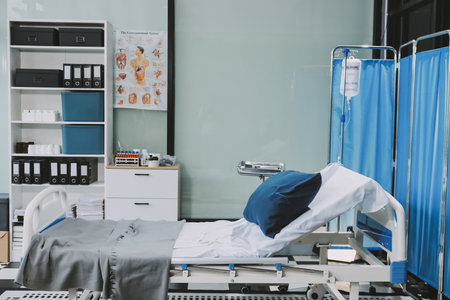1. Understanding the Purpose of a Hospital Tank
If you’re an aquarist in the United States, you know that keeping your fish healthy is a top priority. One of the smartest strategies for managing fish health is setting up a dedicated hospital tank. But why go through the trouble of having a separate tank just for sick or injured fish? The answer lies in both protecting your aquatic pets and maintaining the overall balance of your main display aquarium.
A hospital tank, sometimes called a quarantine tank, serves as a safe haven for sick, stressed, or newly acquired fish. Isolating affected fish reduces their stress levels by providing a calm environment free from competition and aggressive tank mates. More importantly, it prevents the spread of contagious diseases and parasites to the rest of your healthy stock—a crucial step for anyone who wants to avoid a full-blown outbreak in their home aquarium.
Think of it like this: just as humans benefit from medical isolation when they’re ill, fish need their own space to recover without risking the health of others. This approach not only improves recovery rates but also gives you more control over treatment methods such as medication dosing and water quality adjustments—factors that can be tricky to manage in a community tank.
Choosing the Right Tank and Equipment
Setting up an effective hospital tank starts with choosing the right tank size, type, and essential equipment tailored for fish care. Unlike display tanks, hospital tanks are designed for short-term use, focused on treatment and recovery. Here’s what you need to know:
Ideal Tank Sizes and Types
The size of your hospital tank depends on the species and number of fish you expect to treat. Generally, smaller tanks are easier to manage and medicate. Below is a quick reference guide:
| Fish Size/Type | Recommended Tank Size | Tank Type |
|---|---|---|
| Small fish (tetras, guppies) | 5–10 gallons | Standard glass or acrylic |
| Medium fish (angelfish, gouramis) | 10–20 gallons | Standard glass or acrylic |
| Large fish (cichlids, goldfish) | 20–30 gallons+ | Sturdy glass preferred |
A bare-bottom tank is ideal for hospital setups because it makes cleaning and monitoring waste much easier. Avoid decorative substrates, rocks, or plants—these can trap debris and harbor pathogens.
Basic Filtration Needs
Filtration in a hospital tank should be simple yet effective. A sponge filter is highly recommended because it provides gentle water movement, easy cleaning, and won’t suck up sick or stressed fish. Chemical filtration like activated carbon can interfere with medications, so avoid using it when treating illnesses.
Essential Equipment Checklist
- Heater: Maintain stable temperatures suitable for your species; adjustable heaters work best.
- Sponge Filter: For biological filtration without creating strong currents.
- Airstone/Air Pump: Ensures proper oxygenation.
- Thermometer: For accurate temperature monitoring.
- Nets and Buckets: Dedicated tools prevent cross-contamination between tanks.
- Lid or Cover: Prevents jumping and reduces stress from external disturbances.
Pro Tip:
Dedicating all equipment to your hospital tank minimizes the risk of transferring diseases back into your main aquarium. Keep everything clean and only use it for quarantine or treatment purposes.

3. Preparing the Hospital Tank
Before introducing your sick fish to a hospital tank, it’s crucial to create an environment that is both safe and stress-free. Start by thoroughly cleaning the tank with warm water—avoid using soaps or detergents, as these can leave behind harmful residues. Scrub all surfaces, including the inside walls, lid, and any equipment you plan to use, like heaters or filters. Rinse everything well to ensure no cleaning agents remain.
When setting up your hospital tank, keep things minimal. Unlike display tanks, a hospital tank should only contain the bare essentials: a heater (if needed for your species), a gentle filter, and possibly an air stone for extra oxygenation. Skip gravel, decorations, or live plants; a bare-bottom setup makes it easier to monitor waste and medicate effectively. If you want to provide hiding spots to reduce stress, use clean PVC pipes or ceramic ornaments that are easy to disinfect.
Dechlorinating your tap water is a non-negotiable step. Use a reputable water conditioner to neutralize chlorine and chloramines before adding water to the tank. Even trace amounts of these chemicals can be deadly to fish, especially when they’re already compromised by illness. Make sure the water temperature matches that of your main tank to avoid shocking your fish during transfer. By focusing on cleanliness, simplicity, and proper water preparation, you’ll set up a temporary home that gives your sick fish the best chance at recovery.
Maintaining Water Quality and Temperature
Once your hospital tank is set up, keeping the water quality and temperature stable becomes your top priority. Fish in recovery are especially sensitive to environmental changes, so even small fluctuations can hinder their healing. Here’s how to ensure the best conditions:
Daily Monitoring Best Practices
Check water parameters every day using reliable test kits. Ammonia, nitrite, and nitrate levels should be closely watched, as poor water quality can quickly worsen a fish’s condition. Make sure to remove uneaten food and waste promptly—hospital tanks have limited biological filtration, which means toxins can build up faster than in your main aquarium.
| Parameter | Ideal Range | Action if Out of Range |
|---|---|---|
| Ammonia | 0 ppm | Immediate partial water change |
| Nitrite | 0 ppm | Add beneficial bacteria or perform water change |
| Nitrate | <20 ppm | Partial water change |
| pH | 6.8–7.5 (species dependent) | Adjust with buffers if necessary |
| Temperature | 72–80°F (species dependent) | Adjust heater setting as needed |
Adjusting Temperature for Recovery
A consistent temperature helps reduce stress and supports the fish’s immune response. Use a reliable aquarium heater with a built-in thermostat for precision. Some illnesses may require raising the temperature slightly (under guidance from a vet or expert), but never exceed what is safe for your fish species. Always check the temperature at least twice daily—morning and evening—to catch any malfunctions early.
Troubleshooting Tips:
- If the tank is too warm, unplug the heater temporarily and use a small fan over the surface (if needed).
- If it’s too cold, double-check that the heater matches the tank size and isn’t malfunctioning.
- A digital thermometer is usually more accurate than stick-on strip types.
Ensuring Optimal Water Parameters for Healing
The right balance of pH, hardness, and cleanliness creates a supportive environment where medications work effectively and fish can recover faster. Avoid adding chemicals unless necessary—keep it simple: clean water, stable parameters, gentle aeration, and limited light exposure.
Pro Tip:
If you’re treating with medication, check manufacturer guidelines—some meds affect biofiltration or require specific pH/temperature ranges. Always read labels closely to avoid setbacks in your fish’s recovery journey.
5. Introducing and Caring for the Sick Fish
Safe Fish Transfer: Gentle Moves Matter
When it’s time to move your sick fish into the hospital tank, gentle handling is crucial. Use a soft, fine-mesh net or a clean container to transfer your fish, minimizing contact as much as possible. Avoid chasing or scooping quickly, which can stress the fish even further. Before the move, ensure the water temperature in both tanks matches closely to prevent shock. Always wash your hands thoroughly and avoid using any soaps or lotions that could contaminate the water.
Acclimation: Slow and Steady Wins
Proper acclimation helps reduce stress and allows your fish to adjust to the new environment smoothly. Float the fish (still in its transfer container or bag) in the hospital tank for 15-20 minutes, gradually adding small amounts of tank water every five minutes. This step-by-step process helps your fish adjust to differences in water chemistry, such as pH and temperature, minimizing potential health risks.
Medication Processes: Follow Directions Closely
Treating sick fish often requires medicating the hospital tank. Always read medication labels carefully and follow dosing instructions based on your tank’s actual water volume—not just the size of the tank. Overdosing can worsen your fish’s condition. When administering medication, turn off carbon filtration (as it can absorb medicines) but keep up with aeration to maintain oxygen levels. Monitor your fish for signs of improvement or adverse reactions and adjust treatment as needed, consulting aquatic specialists if you’re unsure.
Minimizing Handling: Less Is More
Sick fish are already under significant stress, so minimize physical handling after transfer. Observe from a distance rather than tapping on glass or moving decorations around them. Limit feeding during treatment—offer only what they can eat in a few minutes to reduce waste and keep water quality high. Remember, quiet observation and stable conditions are key to helping your fish recover faster.
6. Disinfecting and Storing the Hospital Tank After Use
Once your fish has completed treatment and is ready to return to the main aquarium, it’s crucial to thoroughly disinfect the hospital tank before storing it away. This step not only prevents the spread of disease but also ensures that you’re ready for any future emergencies.
Effective Cleaning Methods
Start by removing any remaining water, substrate, decorations, and equipment from the tank. Scrub all surfaces with hot water and a dedicated aquarium-safe brush or sponge. Avoid using regular household soaps or detergents, as they can leave harmful residues. Instead, use a diluted bleach solution (one part bleach to nine parts water) for non-porous items like glass tanks, heaters, and nets. Soak these items for at least 10–15 minutes, then rinse them thoroughly with clean tap water until no bleach odor remains. Allow everything to air-dry completely before reuse or storage—sunlight exposure can help break down any leftover chemicals.
Safe Disposal of Water
Hospital tank water may contain medications and pathogens, so never pour it directly into storm drains or garden beds. Instead, dispose of the used water in a household toilet or utility sink connected to the sanitary sewer system. Rinse out buckets and siphons with hot water and allow them to dry fully before storing.
Proper Storage Tips
Once all components are clean and dry, store the hospital tank and its equipment in a cool, dry place away from direct sunlight. Keep all parts together—tank, heater, filter (if used), air stone, and nets—in a plastic tote or box labeled “Hospital Tank” so you can find everything quickly during future fish emergencies. Periodically check stored equipment for cracks or wear to ensure it’s always ready when you need it most.
A Habit Worth Building
Disinfecting and storing your hospital tank after each use isn’t just good practice; it helps protect your entire aquarium community from recurring illness. By making this a regular habit, you’ll be better prepared for whatever comes next—and give your fish the best possible chance at a healthy recovery.

